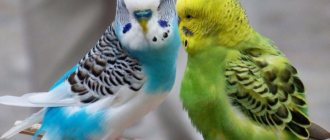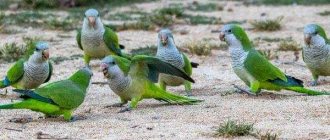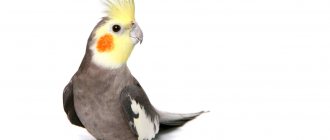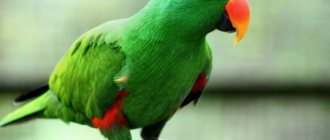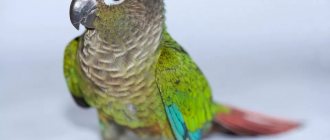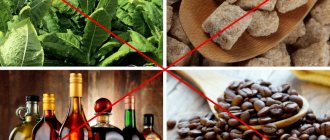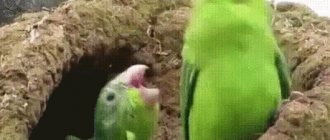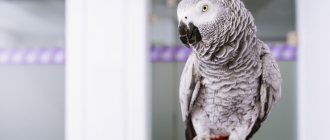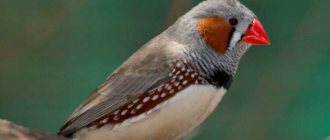The budgerigar is a member of the family Psittaculidae, order Psittaculidae. It belongs to the genus Melopsittacus, where it is the only type specimen. The bird is active and noisy, distinguished by its small size and bright multi-colored plumage.
Budgerigars were first introduced en masse to Europe in 1840. They quickly gained popularity, and over time, these exotic birds became the most common species among indoor birds. Which continent is the homeland of budgerigars, and what habitat is typical for them in the wild.
Where are you from?
The native land of budgerigars is Australia and its adjacent islands. Motley noisy flocks have filled almost the entire territory of the country. The only exceptions are certain areas in the northern part of the continent. Coniferous forests and deciduous trees grow densely there, and parrots prefer flat terrain with a lot of grass and succulent plants.
The ideal climate for wavy individuals is tropical and subtropical. Therefore, they subsequently easily adapted to other countries with suitable natural conditions:
- South America;
- Southeast Asia;
- India;
- Western part of Africa.
There are 2 subspecies of budgerigars - the North Australian and Western Australian type. They are distinguished by the color of the plumage on their heads. North Australian birds have a much darker shade.
Origin of the species
In 1770, Englishman James Cook and his team reached the shores of Australia. The famous traveler and his sailors became the first Europeans to see flocks of budgerigars. In those days, local aborigines actively hunted birds in order to later eat them. Australian artist Thomas Watling drew the first drawing of a budgerigar.
A detailed description of the exotic bird appeared in Europe in 1805. Its author was the English naturalist George Shaw. The work was called “Naturists miscellany”, and the artist Frederick Nodder accompanied the book with illustrations. Later, in 1837, British ornithologist John Gould presented to the world a voluminous scientific opus about the life of parrots in their natural habitat.
His work was so thorough that subsequent studies by ornithologists did not add any significant facts to it. In the period 1840-1848, Gould published the famous publication "Birds of Australia". It includes 36 books, one of which has a separate chapter dedicated to budgies.
Since the 40s of the 19th century, mass deliveries of parrots to Europe began. They were transported by sea in common cages. On the way, heat-loving birds fell ill in large numbers and died before reaching the shore. Australian authorities quickly responded to the situation and banned the export of all types of wild birds from the country. This law is still in effect. The exception is chicks raised in captivity.
Range and habitat
Australia is a separate continent. Budgerigars are adapted to the local climate, are not afraid of the rainy season and quickly find areas where they are fed and comfortable. Birds like to settle on wide plains where there is a lot of grass and bushes. They prefer savannas with sparsely growing single trees, choosing places near streams and ponds. They readily inhabit mountain ranges and eucalyptus groves.
On their native continent, parrots live en masse on the east and southwest coasts. Numerous flocks live on the island of Tasmania and its neighboring islands. In countries where birds were brought for population, parrots strive to find their familiar environment. Therefore, they prefer steppe plains with low bushes and grassy meadows with lush greenery. They choose an area where the natural conditions are as close as possible to their native Australian lands.
If the dry season happens to be very long, birds are able to fly long distances. When the flock finds a suitable place where there is food and water, it remains there until the food runs out. After which the birds again set out in schools in search of a comfortable parking spot.
The color scheme of parrots in the wild is a yellow head with a green body and black wavy patches. This coloring allows them to blend in with the vegetation and serves as camouflage from birds of prey and animals. The rainbow color appeared in domestic animals after the intervention of breeders.
Varieties of wild budgerigars
The varied shades of budgerigars are solely the merit of talented breeders who have bred more than two hundred varieties of this bird. In the wild, things are different. In the wild you can only find light green parrots of the traditional color. The bird's mask is yellow, with black dots on its neck.
Wild wavy birds have some color features that only an ornithologist can identify. Scientists distinguish two types of Australian budgerigars:
- North Australian.
- Western Australian.
The North Australian budgerigar differs from its western counterpart in the dark shade of the feathers on its head. It is difficult to separate one species from another, because within the same flock the colors of the birds vary greatly.
Lifestyle
The budgerigar is a collective and nomadic bird. Flocks can number from several tens to hundreds of units. In rare cases, the number can reach a thousand or more. There is no clear hierarchical system, but each bird knows its place. Thanks to this, they coexist peacefully in their community, without trying to gain leadership. Fights occur only between males during the mating season.
Parrots value family and loyalty. When a pair has formed, they create offspring and subsequently conscientiously take care of their chicks. The male remains faithful to his half forever, and no longer looks for another female.
Lifestyle depends on external factors; lifestyle can be divided into 2 periods:
- Nomadic . Birds are constantly migrating in search of food and water. This occurs during the cold season and during periods of drought. Then it becomes difficult to find plants and insects, and ponds quickly dry up. Under such conditions, the flock can move considerable distances every day.
- Sedentary . When the rainy season passes, nature blossoms and all the pools and storage facilities are filled with water. During this period, the birds find a suitable area and sit there until their supplies run out. Parrots lead a similar way of life during nesting.
All members of the pack take care of each other. If one notices a possible danger, he immediately informs all his brothers about it. They also signal when they find food or a suitable resting place. Ornithologists still have not been able to figure out how budgies manage to predict the approach of rains and cyclones. However, birds always unmistakably sense weather changes and fly to favorable conditions.
The flock lives according to an unspoken daily routine. At dawn, everyone goes to water, after which it is time to feed. Parrots feed for several hours and then hide on branches and in thickets to rest. In the evening they come out for a quick feeding before roosting for the night. With the arrival of darkness, the birds return to their shelters and remain there until the morning.
The age of a budgerigar can be easily determined by its tail and plumage color. In adults, the tail is long and stepped, while in juveniles it is much shorter. Also, in young birds, the variegated wavy inclusions are blurred, and in mature birds they acquire a clear contour pattern.
Nutrition
In the natural environment, parrots feed on plant foods and insect larvae. The usual diet includes the following components:
- wild crop seeds (Mitchell grass, millet, anigozanthos or kangaroo grass);
- shoots, foliage and flowers of young plants;
- berries and fruit pulp;
- small insects or their larvae;
- grain crops.
Peaceful and harmless parrots often become a serious threat to farms. A large flock can quickly destroy a grown crop. Farmers are fighting and exterminating them en masse, which has become the main reason for the decline in the number of wild parrots.
Reproduction
Thanks to the warm climate, budgies can breed all year round. Usually they choose a period when there is no drought and nature blooms. They prefer to nest in tree hollows or in secluded places on wide branches. The female does not need bedding; she lays her eggs on a bare surface. They incubate for 17-21 days, with 4-10 chicks per brood.
Babies are born blind and unfeathered, and gain sight in 10-12 days. It takes up to 50 days for the offspring to fully adapt, after which the chicks leave the parental nest and live independently. During the entire period of incubation and rearing, the male takes care of his family. Carries food and water, helps the female raise the young.
When the nest is empty, the parents are ready to immediately have new offspring. If the time is dry or cold weather is expected, the parrots leave their nests and fly away in search of a new site.
In males, the feathers on the forehead when exposed to ultraviolet rays begin to fluoresce (in simple terms, glow). This property helps them more easily attract a female during the mating season.
What did Australian sparrows traditionally eat?
The budgerigar has a strong beak with sharp serrations along the edges. It easily cracks nuts and shells large seeds from bushes. The bird gives preference to small grass seeds, about 20 varieties, which it can swallow completely. The degree of ripeness does not play a special role.
In the places where budgerigars live, there are few trees; they prefer bushes and tall grass up to a meter high. Having found a suitable place, they quickly peck everything, running from place to place along the ground. Particularly active in the morning. The fruits, peeled from rough shells, are first sent to the crop, then partially digested into the stomach.
Birds prefer bushes and grass
A budgerigar can eat tree fruits. This mainly occurs at the beginning of the rainy season, when the birds begin to incubate and feed their chicks. Then they prefer soft food. The offspring that leave the nest are fed by their parents for about another 3 weeks. They fly up to a flock of young animals and call their cubs.
The babies leave the nest at the age of 30–50 days. All this time, their parents feed them, regurgitating half-digested food. The parrot is a social creature. They build nests close to other families, choosing a pair forever. Ornithologists consider wavy birds to be in pairs. Birds easily change a flock with which they have lived for some time for another. Whoever first noticed food or water warns the entire flock with special signals. This helps them survive in difficult conditions.
Unlike large breeds of parrots, budgies never eat larvae, pupae or other forms of insects. They can gnaw the bark, separating it from the trunk with their strong beak and breaking it into pieces.
Breeding history
After John Gould brought a budgerigar to England in 1840, the strange bird began to be delivered by sea to Germany, Belgium and France. The cost was high, so European breeders immediately began trying to breed offspring in an artificial environment.
The first brood was obtained by the French poultry farmer Solby in 1854. His compatriot, Jules Delon, published an article in which he described the rules for keeping and caring for a budgie. In 1855, Germany reported its successful experiments in breeding chicks in captivity. The offspring appeared in the house of Countess von Schweren. In Belgium, scientists at the Antwerp Zoo were breeding parrots.
Large companies from leading countries responded to the demand, and by 1860 all famous zoos had already started breeding exotic birds. In 1880, 25 thousand chicks were bred in Germany alone. In Russia, scientists studied budgies in 1930. They were first raised at the Moscow Zoo.
Thanks to the work of world breeders, by the middle of the 20th century there were more than 200 species of domestic budgerigars.
What to feed your pet wavy
The main diet of a budgie living in a house should consist of several types of seeds:
To this it is advisable to add store-bought ones that grow in the birds’ homeland: Senegalese millet, pausa, chumizu.
A budgie should not be given fried seeds and various honey sticks and citrus fruits.
You should definitely include fruits in your diet:
Mineral supplements can only be poured into the feeder of adult birds; young birds should not. Just hang a cuttlefish shell - sepia and the parrot will replenish its diet with calcium and strengthen its feathers. Birds should have fruits constantly, and not as a delicacy. In addition, you need to put a drinking bowl with water. Regularly place branches from fruit trees in the cage. The parrot will gnaw the bark and climb on them.
The budgerigar is an Australian sparrow
Interesting Facts
The budgerigar is a unique bird in its family, as evidenced by the following features:
- Tenacious paws with 4 claws - 2 claws pointing forward, 2 backward. This structure allows you to deftly climb trees and confidently and quickly walk on the ground. Parrots are a rare species of birds that are able to take food not only with their beaks, but also with their paws.
- Excellent hearing and good sense of rhythm. They can really grasp the tempo subtly and move rhythmically to the beat.
- Birds have a developed memory and remember words. But they repeat them mechanically, without grasping the meaning. In 1995, Puck the parrot was included in the Guinness Book of Records for learning more than 1,700 words.
- Movable neck. The muscles are so flexible that the bird is able to turn its head 180 degrees.
- Keen vision, with a wide overview. They see the world in color.
- Parrots do not have vocal cords. They make sounds using the larynx and tongue, which is short and thick.
Budgerigars are calm and hardy birds. In their homeland, they know how to adapt to weather conditions and are not afraid of winds and rains. They are tirelessly busy searching for food and taking care of their family. In their natural habitat, they know how to live harmoniously in a flock and overcome difficulties together with their wavy brothers.
Description
These are very slender beautiful parrots. Body length is 17-19.8 cm, sometimes large individuals up to 21-22 cm long are found. Wing length is 9.5-10.5 cm, tail - 8-10 cm; weight 40-45 g. Thanks to the tail, it seems much larger.
The main color of the plumage is a protective (protective) grass-green color. The front of the head and throat are yellow. On the sides of the head there are elongated purple spots, under which there are three black spots on each side of the throat. The back of the head, the back of the head and the top of the back with dark brown undulations on a yellow background. The waviness on the head changes from fine and gentle to the back into a wider and coarser one. In young birds, the wavy pattern is not as clear as in adults, and begins immediately from the cere. They retain this color until a yellow mask appears. Young birds have a much shorter tail than adults. The tail is long and stepped.
The feathers on the forehead of a male budgerigar have an interesting property: they fluoresce under the influence of ultraviolet rays. The human eye is able to see this glow only in the dark, but parrots can distinguish it even in bright sunlight. Under natural conditions, the presence of fluorescence plays an important role when females choose a nesting partner. An experiment was conducted: two cages with males were illuminated with daylight, but one of them was screened with glass from direct solar ultraviolet radiation. In 9 out of 10 cases, the female chose the male located in an unshielded cage.
The eyes of budgerigars are dark blue, the iris is yellow or white. Parrots' eyes distinguish colors. In addition, they have a wide angle of view, which allows you to see two perspectives at the same time.
The beak of budgerigars is powerful and curved, like a bird of prey. On top it is covered with a strong stratum corneum. At the base, the cere on which the nasal openings are located is strongly visible. The beak of parrots, unlike other birds, is very mobile thanks to the upper jaw, which does not grow together with the skull, but is connected to it by a tendon ligament. The upper jaw is much longer than the lower jaw. The palatine bones are well developed. This beak is a universal tool for plucking and chopping small branches, leaves, seeds and various fruits. With their beak, budgerigars lift and carry various objects, as well as food and drink. In addition, they use it to climb tree branches, cage bars and enclosure mesh, sometimes for defense. With the help of their powerful beak, parrots hollow out hollows for nests. The tongue of budgerigars is short and thick, slightly rounded. At the tip it is covered with a stratum corneum. Most have narrow horny teeth on the inside of the beak, which, like a file, sharpen the front part of the beak and clear the grains from the husk, and are also used for picking fruits and gnawing them. In chicks, the beak is dark, in adult birds it is straw-yellow, with a greenish tint. Above the beak of birds around the nostrils there is a well-defined cere. The sex of birds is easily distinguished by the color of the wax: in a young male it is purple, in an adult it is bright blue, in a female it is blue (there is a lighter rim around the nostrils), in an adult it is blue or brown.
The neck of parrots is very mobile, since their beak performs the main grasping function. The skeleton of the body, on the contrary, is inactive, since it mainly performs a supporting function.
The wings of a parrot are used only for flight and do not support the body at all while moving or sitting. The flight of a budgerigar is slightly arched and resembles the flight of a swallow. When landing, the wings bend downward, making it similar to the landing of a quail.
The paws are grayish-blue, very strong and tenacious, the claws are dark blue or black. Each paw has 4 long, curved and rather sharp toes, 2 of which point forward and 2 point back. Thanks to this design, parrots very dexterously climb branches, walk on the ground, and can also grab various objects with their paws, including food, and carry them or hold them near their beak.
